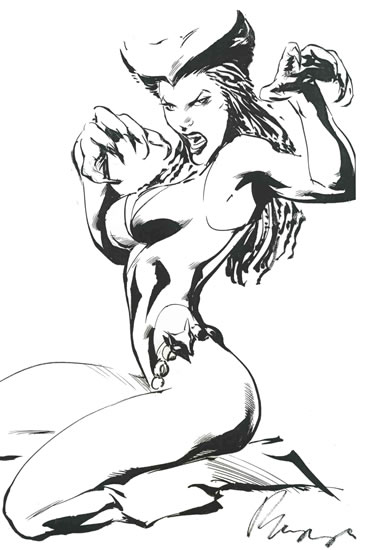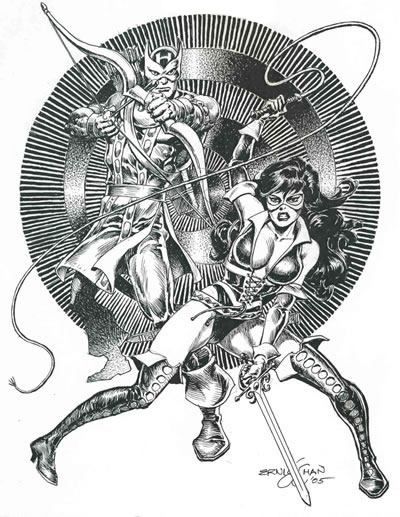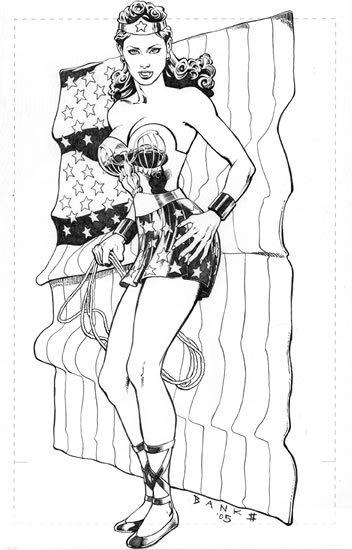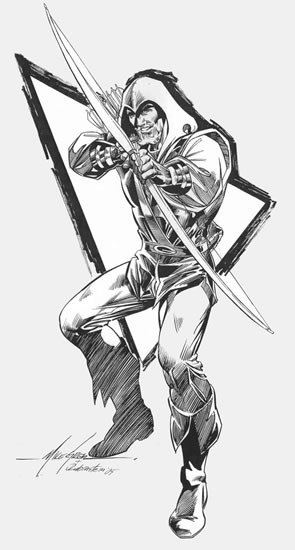This week's edition of Comic Art Friday is sponsored by the NBA's
Golden State Warriors, who are finally beginning to look like something after a long, agonizing decade of frustration for fans. With the late-season addition of
Baron Davis last year, and the continuing maturation of young stars
Jason "J-Rich" Richardson and
Troy "T-Murph" Murphy, coach Mike Montgomery's Warriors at last are living up to their shopworn tagline: "It's a Great Time Out."
While we're on the subject of teams, it was a great day in the history of comics when some wise soul decided that if one superhero was good, a whole gaggle of superheroes would be awesome. That wise soul was probably DC Comics editor Sheldon Mayer, generally credited with the creation of
the Justice Society of America, comics' original superteam, in a 1940 issue of
All-Star Comics. The JSA threw together such diverse second-string characters as the Flash, Green Lantern, Hawkman, the Atom, Dr. Fate, and Hourman to deliver a fighting force such as evil had never before faced. As the group became more successful, even DC's Big Three — Superman, Batman, and Wonder Woman — joined up. Over time, practically every hero and heroine whose adventures the company published hitched his or her star to the JSA. The abundance of characters made for some crowded panels, but also for terrific comics.
When DC resurrected its largely moribund superhero franchise in the late 1950s, one of the first orders of business was introducing a revamped version of the JSA, this time called
the Justice League of America. The Big Three were back — unlike their JSA compatriots, Supes, Bats, and Wondy never totally went away — along with fresh takes on old heroes like the Flash, Green Lantern, and Green Arrow, plus newcomers Aquaman and the Martian Manhunter. Comics fans felt as though they got more bang for their dime with so many super-types cramming the pages, and the JLA books sold like the proverbial hotcakes.
Over at struggling Marvel Comics (or Timely, or Atlas, or whatever the heck their name was then), editor Stan Lee saw the JLA as the key to comics' future. With artist Jack Kirby, Lee co-created a new superteam, the Fantastic Four. And — as Stan himself might have written, —
comics would never be the same again! Lee and Kirby followed up on the success of the FF with another hero group, the X-Men (whom Lee wanted to call "the Mutants," until convinced by his publisher Martin Goodman than no one reading comic books in the early 1960s knew what a mutant was).
To this day, superteams account for some of comics' best-known franchises. Both the Justice League and the X-Men have spawned a veritable plethora of splinter groups, and of course remain hit properties in their own right. The Justice League became a TV animation staple, first in the lovingly recalled
Super Friends, and today in Cartoon Network's various
Justice League series. The X-Men spun off a string of hit animated shows for the Fox network, then moved into the blockbuster live-action movies directed by Bryan Singer.
Even with all of this, the JL-whatever and X-infinitum represent but the tip of the supergroup iceberg: Avengers, Defenders, Champions, New Mutants, Power Pack, Outsiders, Birds of Prey, Youngblood, Gen13, WildCATS, Force Works... The list is endless and ever-growing. As they did in 1940, comics readers love to see a whole mess of heroes ganging up and getting their fight on, so the rise of the super-squads isn't likely to end anytime soon.
Since this is Comic Art Friday, let's get to some superteam art. First up, a gathering of X-Men, as drawn by
the comic artist who calls himself simply Buzz:

Seen here, moving clockwise from the far left, are Gambit, the ragin' Cajun who energizes playing cards with explosive force; Phoenix, one of the incarnations of the character originally known as Marvel Girl, and now most often called by her given name, Jean Grey; Storm, the African demigoddess with the power to control the weather; the Beast, another of the original X-Men, though he's changed a good bit in appearance since the Kirby days; and Wolverine, probably the most influential character introduced during comics' Bronze Age in the '70s.
The artist Buzz is best known for his work illustrating another supergroup, the modern version of the Justice Society of America. I had an opportunity to meet the Burmese-born Buzz at WonderCon last February, and was both delighted by his engaging personality and awed by his tremendous talent. He is one of the most skillful brush inkers in the industry, as demonstrated by this portrait he created for me, of Mari McCabe,
aka the Vixen:

The Vixen, DC Comics' first black superheroine, enjoyed her most visible role as a member of yet another superteam,
Suicide Squad. Like many superteams, the Squad was comprised of misfit, B-level heroes and heroines, none of whom could sustain a solo series, but who made an intriguing contrast of supertypes. With cleverly plotted adventures written mostly by the husband-and-wife team of John Ostrander and Kim Yale,
Suicide Squad remains a highly regarded cult classic among supergroup aficionados.
For roughly the last half of
Suicide Squad's run in the late '80s and early '90s, SSTOL favorite
Geof Isherwood was a key component of the series' creative team, first as inker over the pencils of Luke McDonnell, and later as primary penciler. Here, Geof reunites four of the Squad's pivotal members in a tension-fraught scenario:

Down front with the Vixen is the master of martial arts, the Bronze Tiger; up top are the mysterious Nightshade and the rogue warrior Deadshot. Isherwood's incredible sense of drama and deft linework, along with his obvious affection for these characters, make this pencil artwork one of my most treasured commission projects.
And that's your Comic Art Friday. Have your superpeople call my superpeople. We'll do superlunch.



























